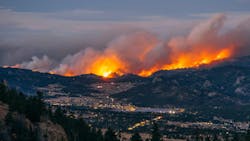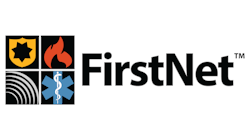Advanced Communication Tech at Cameron Peak
The Cameron Peak Fire was the largest wildland fire in Colorado’s history. The fire started on Aug. 13, 2020 and ravaged more than 200,000 acres until it finally was contained on Jan. 12, 2021. It forced the evacuation of tens of thousands of people and required more than 1,500 personnel to fight.
Don Patterson, a firefighter and communications expert, deployed to the Cameron Peak Fire knowing that broadband communications would play a huge role. Responding to this historic fire required advanced communication technologies, particularly with the threat of COVID-19 complicating the incident response.
Bringing internet to the woods
Patterson, who serves with Berthoud, CO, Fire Protection District, is known by his colleagues as the guy who can bring “internet to the woods”—and that’s what he did at Cameron Peak. Along with his communications unit leader and medical unit leader, Patterson requested so-called deployables from FirstNet to bring coverage to the remote, rugged area where the fire was spreading.
“We had some struggles with other carriers, especially when it came to providing the service down the line,” Patterson said. “We were getting overwhelmed and oversubscribed, especially because we were close to neighborhoods. That’s because broadband traffic from nearby residents was causing congestion on commercial networks.
“With FirstNet, we were able to lock down the assets to Band 14 [the FirstNet broadband spectrum that’s dedicated to first responders],” he added. “Once we started putting FirstNet-enabled phones in the hands of people in the field, that’s when lightbulbs went off. A lot of people looked at it and said, ‘Oh. So, no one else can access it but me right now on this phone.’”
Patterson says that even when someone had a different carrier but was connected to FirstNet via hotspot, they were amazed at the capabilities of FirstNet.
“They saw the speed of the service,” Patterson says “They saw the connectivity. They saw that there wasn’t any latency that we would get in the past. They’ve seen why FirstNet is really important.”
Putting deployables on the fire line
At Cameron Peak, two deployables were stationed in the field to support responders on the fire line. Patterson led the preplanning efforts to locate the deployables where frontline responders could access them and to make contingency plans if the fire approached the deployable.
Within hours of providing basic operational information—such as the event type, location and terrain—two FirstNet Satellite Cell on Light Trucks (SatCOLTs) were on site. (SatCOLTs are a type of deployable cell site that brings service to hard-to-reach areas.)
The SatCOLTs were sent to two strategic locations on the fire line—one at Jacks Gulch Campground and one at a Boy Scouts campground. This positioning allowed critical information to be shared with everyone from incident command at the base camp to frontline firefighters.
“Our boots on the ground, our divisions, our branches, our taskforce leaders, even the firefighters themselves, were literally counting on that communication asset,” Patterson said.
A wildfire unlike any other
In the past, Patterson worked fires where deployables were sent to the incident command post, but he knew this time had to be different. The Cameron Peak Fire spread at speeds of up to four miles per day. Firefighters on the ground needed fire maps that updated in real time; apps to access the GPS coordinates for landing helicopters; and video feeds from airplanes that detected the spread of the fire.
Plus, with everyone dealing with new restrictions because of COVID-19, the amount of data traffic increased greatly at the Cameron Peak Fire. Check-ins by newcomers and demobilizations from people going home were done online instead of in-person. Timecards were certified virtually on the fire line. Daily briefings were conducted remotely through video conferencing tools in addition to land mobile radio (LMR).
When a person on-site tested positive for COVID-19, the incident command post was locked down, and more than 100 firefighters had to quarantine at the forward operating base.
“We needed to know a lot of information about our people and the situation, and it needed to be up to the minute,” Patterson said. “With that much information being shared constantly, you could literally take down an LMR network.”
During this “incident within an incident,” FirstNet’s broadband connection allowed firefighters to stay connected and for incident command to push data to multiple audiences at one time.
Connecting to home
Patterson says one of the biggest benefits of having a broadband connection was that fire personnel were able to connect to friends and families at home. Fire personnel, who typically are on site for 2–3 weeks at a time, used the broadband connection that was provided by FirstNet deployables to call, text and even video chat with people at home.
“Normally in the field, we have no way of contacting our family,” Patterson said. “They have no way of contacting us. And what I saw at Jacks Gulch Campground were guys able to communicate home, communicate back to their departments, letting their departments and their families know that they’re OK.”
The morale boost that everyone gets from calling home benefits the mission.
“That peace of mind allows you to come back and do the job even harder,” Patterson said.
Best practices for deployables on the fire line
- Patterson says he learned a lot from overseeing deployables on the fire line at Cameron Peak. Some of his best practices include:
- Make a game plan for a deployable(s). Identify a location for the deployable. Establish your contacts for requesting the deployable ahead of time. Understand the deployable ordering process. Assign someone who is field-qualified to manage the deployable if it’s going to be on the fire line. Analyze your need for FirstNet-capable devices and hotspots and formulate a request to obtain them.
- Plan for contingencies. Make sure the deployable is in a safety zone. Plan for an evacuation or shelter-in-place for the deployable if fire threatens it. Identify a trigger point for when to initiate contingency plans. Devise a back-up plan for communications in case of evacuation.
- Utilize broadband and LMR for the best of both worlds. Create redundancy. Alleviate traffic on the LMR network by sharing data over broadband. Rely on LMR and add data capabilities with broadband on the fire line.
To learn more about how broadband was used at Cameron Peak, check out the video below:
Tracey Murdock
Tracey Murdock is a senior public safety advisor for the First Responder Network Authority (FirstNet Authority), serving public safety stakeholders in Colorado, North Dakota, South Dakota, Utah and Wyoming. Her mission is to listen, inform and advocate for first responder communication requirements on the only nationwide broadband network that’s designed for public safety. Prior to joining the FirstNet Authority, Murdock served as the emergency management program director for Navy shore commands in an 11-state region. Her expertise encompassed emergency dispatch, emergency operation centers, consequence planning, defense support to civil authorities and coordinating a national-level, multi-agency response task force for nuclear weapon incidents. Murdock’s experience includes disaster response as well as planning and directing large-scale exercises in Europe and Southwest Asia. She served 24 years in the U.S. Navy.







